Gallery
- Irish Fleabane
- Strawberry tree
- Kerry lily
The Lusitanian flora is a small assemblage of plants that show a restricted and specific distribution in that they are mostly only to be found in the Iberian Peninsula or southwest Ireland. [1] [2] Generally, the plants are not found in England or western France even though suitable habitat almost certainly exists in those regions. The plants currently number about 15 species in total and include examples such as Irish fleabane, strawberry tree and St Patrick's-cabbage. The group is of particular interest and importance since it is currently not understood how the current geographical distribution came about. This biogeographical puzzle has been a topic of academic debate since the middle of the 19th century. Conflicting, and as yet unresolved theories centre on whether the Irish populations are a relict, surviving from before the last ice age or whether they have been transported there in the last 10,000 years. Many of the species are also very restricted in their distribution in Ireland, and have become the centre of intense conservation efforts in recent years, for example the Irish Fleabane.[ citation needed ]
Today it is often stated that these species are native to Ireland [3] and it has been proposed that they probably survived the last ice age in refuges, for instance work on St Dabeoc's Heath. [4] However, Micheline Sheehy Skeffington and co-workers have assembled evidence indicating that several of the Lusitanian plant species were introduced by people traveling by sea from northern Spain. Her initial publications on Mackay's Heath ( Erica mackayana ) suggest this species was introduced to the west coast of Ireland as several discreet colonies in remote locations through smuggling. [5] This hypothesis has been confirmed by a Spanish genetic study. [6] She has since presented evidence for the introduction of the five other heath-land Lusitanian species; Kerry Lilly (Simethis mattiazzii), [7] Cornish Heath (Erica vagans), Irish Heath (E. erigena), Dorset Heath (E. ciliaris) and St Dabeoc's Heath (Daboecia cantabrica). [8] Her evidence suggests that only the first two were also introduced though smuggling, while Irish Heath appears to have arrived several centuries before the smuggling, in the 15th century, possibly through the pilgrimage by sea to Santiago de Compestella and St Dabeoc's Heath appears to have been introduced prior to historical times. Her other work on Strawberry Tree (Arbutus unedo) shows that it was probably introduced 4,000 years ago by the miners who worked the first copper mine in northern Europe which was on Lough Leane near Killarney in south west Ireland and it was spread from their to successive copper mines in south west Ireland and possibly also to north Wales where is grows near the bronze age copper mine on the Great Orme. [9]

The Ericaceae are a family of flowering plants, commonly known as the heath or heather family, found most commonly in acidic and infertile growing conditions. The family is large, with about 4,250 known species spread across 124 genera, making it the 14th most species-rich family of flowering plants. The many well known and economically important members of the Ericaceae include the cranberry, blueberry, huckleberry, rhododendron, and various common heaths and heathers.

Erica arborea, the tree heath or tree heather, is a species of flowering plant (angiosperms) in the heather family Ericaceae, native to the Mediterranean Basin and Ethiopia, Kenya and Tanzania in East Africa. It is also cultivated as an ornamental.

Arbutus is a genus of 12 accepted species of flowering plants in the family Ericaceae, native to temperate regions of the Mediterranean, western Europe, the Canary Islands and North America, and commonly called madrones or strawberry trees. The name Arbutus was taken by taxonomists from Latin, where it referred to the species now designated Arbutus unedo.
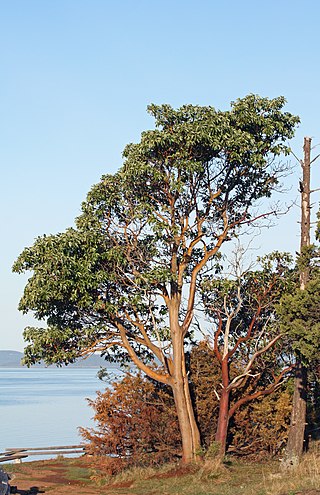
Arbutus menziesii, or Pacific madrone, is a species of broadleaf evergreen tree in the family Ericaceae. It has waxy foliage, a contorted growth habit, and flaky bark.

Daboecia, or St. Dabeoc's heath, is a small genus of flowering plants in the family Ericaceae, containing two evergreen shrubs, closely related to the genus Erica. They are native to cliffs and heathland in southern Atlantic Europe and the Azores.

Arbutus unedo, commonly known as strawberry tree, also called madrone, is an evergreen shrub or small tree in the family Ericaceae, native to the Mediterranean Basin and Western Europe. The tree is well known for its fruits, the arbutus berry, which bear some resemblance to the strawberry, hence the common name strawberry tree. However, it is not closely related to true strawberries of the genus Fragaria.

Erica tetralix, the cross-leaved heath, is a species of flowering plant in the family Ericaceae, native to western Europe.
Arbutus may refer to:

In biology, a taxon with a disjunct distribution is one that has two or more groups that are related but considerably separated from each other geographically. The causes are varied and might demonstrate either the expansion or contraction of a species' range.
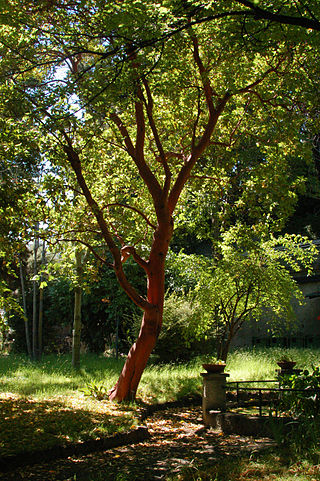
Arbutus andrachne, commonly called the Greek strawberry tree, is an evergreen shrub or small tree in the family Ericaceae, native to the Mediterranean region and the Middle East.
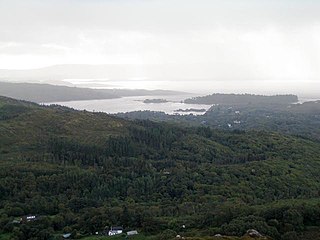
Glengarriff Forest is an area of woodland near Glengarriff, West Cork, Ireland. Most of the woodland is a nature reserve in public ownership which is sometimes referred to as Glengarriff "forest park" or "state forest".
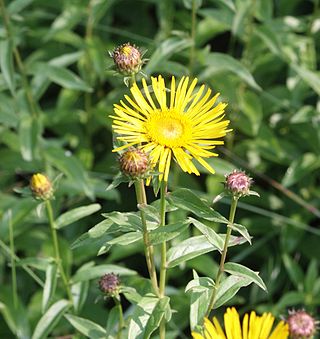
Pentanema salicinum is a plant species in the family Asteraceae. It is found across Eurasia from Portugal to Japan. It has been reported growing in the wild in a few scattered locations in North America but it has not become widely established there.
Irish heath is a common name for two closely related species of flowering plants in the heather family Ericaceae:

The Arbutoideae are a subfamily in the plant family Ericaceae. Phylogenetic analysis supported all genera of the subfamily as monophyletic, except Arbutus. Moreover, it was suggested that the non-sister relationship between Mediterranean and North American species may be explained by a once widespread distribution in the Northern hemisphere before the Neogene.

Mihrabat Nature Park is a nature park located on the Asian part in Beykoz district of Istanbul Province, Turkey.
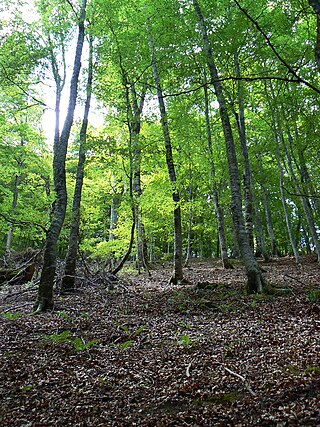
The flora of Cantabria is the result of three determining factors: the climate, the composition of the soil, directly dependent on the types of existing rocks, and the evolutionary history of the different plant formations.

Micheline Sheehy Skeffington is an Irish botanist and equity advocate. Elected President of the Botanical Society of Britain and Ireland in November 2022, she was the third woman and second Irish person to hold the position since the Society's founding in 1836.

Erica mackayana, also known as Mackay's heath, is a species of flowering plant in the family Ericaceae.